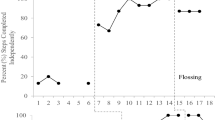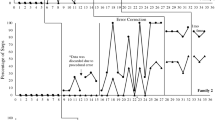Abstract
This was the first study to evaluate procedures for teaching leg shaving to individuals with disabilities. Using a video prompting teaching package in a concurrent multiple baseline design across participants with different diagnoses (i.e., paraplegia, Down Syndrome, and intellectual disability), all participants learned to shave their legs and maintained responding two weeks post-intervention.

Similar content being viewed by others
Data Availability
The datasets generated during and/or analyzed during the current study are available from the corresponding author on reasonable request.
Code Availability
Information regarding software used in this study is available from the corresponding author on reasonable request.
References
Charlop-Christy, M. H., Le, L., & Freeman, K. A. (2000). A comparison of video modeling with in vivo modeling for teaching children with autism. Journal of Autism and Developmental Disorders, 30(6), 537–552. https://doi.org/10.1023/a:1005635326276
DeLeon, I. G., & Iwata, B. A. (1996). Evaluation of a multiple-stimulus presentation format for assessing reinforcer preferences. Journal of Applied Behavior Analysis, 29(4), 519–533. https://doi.org/10.1901/jaba.1996.29-519
Gardner, S. J., & Wolfe, P. S. (2015). Teaching students with developmental disabilities daily living skills using point-of-view modeling plus video prompting with error correction. Focus on Autism and Other Developmental Disabilities, 30(4), 195–207. https://doi.org/10.1177/1088357614547810
Mays, N. M., & Heflin, L. J. (2011). Increasing independence in self-care tasks for children with autism using self-operated auditory prompts. Research in Autism Spectrum Disorders, 5(4), 1351–1357. https://doi.org/10.1016/j.rasd.2011.01.017
Reimers, T. M., & Wacker, D. P. (1988). Parents' ratings of the acceptability of behavioral treatment recommendations made in an outpatient clinic: A preliminary analysis of the influence of treatment effectiveness. Behavioral Disorders, 14(1), 7–15.
Rosenberg, N. E., Schwartz, I. S., & Davis, C. A. (2010). Evaluating the utility of commercial videotapes for teaching hand washing to children with autism. Education and Treatment of Children, 33(3), 443–455. https://doi.org/10.1353/etc.0.0098
Shipley-Benamou, R., Lutzker, B. R., & Taubman, M. (2002). Teaching daily living skills to children with autism through instructional video modeling. Journal of Positive Behavior Interventions, 4, 166–177. https://doi.org/10.1177/10983007020040030501
Sigafoos, J., O'Reilly, M., Cannella, H., Edrisinha, C., de la Cruz, B., Upadhyaya, M., Lancioni, G. E., Hundley, A., Andrews, A., Garver, C., & Young, D. (2007). Evaluation of a video prompting and fading procedure for teaching dishwashing skills to adults with developmental disabilities. Journal of Behavioral Education, 16(2), 93–109. https://doi.org/10.1007/s10864-006-9004-z
Veazey, S. E., Valentino, A. L., Low, A. I., McElroy, A. R., & LeBlanc, L. A. (2016). Teaching feminine hygiene skills to young females with autism spectrum disorder and intellectual disability. Behavior Analysis in Practice, 9(2), 184–189. https://doi.org/10.1007/s40617-015-0065-0
Williamson, H. (2015). Social pressures and health consequences associated with body hair removal. Journal of Aesthetic Nursing, 4, (3), 131–133. https://doi.org/10.12968/joan.2015.4.3.131
Funding
The authors did not receive support from any organization for the submitted work.
Author information
Authors and Affiliations
Contributions
All authors contributed to the study conception and design and read and approved the final manuscript.
Corresponding author
Ethics declarations
Conflicts of Interest
The authors have no conflicts of interest to declare that are relevant to the content of this article.
Ethics Approval
This study was reviewed and approved by the Caldwell University Institutional Review Board and performed in accordance with the ethical standards as laid down in the 1964 Declaration of Helsinki and its later amendments.
Consent to Participate
Freely-given, informed consent to participate in the study was obtained from all participants.
Consent for Publication
Freely-given, informed consent to use data obtained during the study for publication purposes was obtained from all participants.
Additional information
Publisher’s Note
Springer Nature remains neutral with regard to jurisdictional claims in published maps and institutional affiliations.
Rights and permissions
About this article
Cite this article
Folgia, N., Sidener, T.M., Pantano, N.A. et al. Using Video Prompting to Teach Leg Shaving to Women with Disabilities. Behav Analysis Practice 16, 296–301 (2023). https://doi.org/10.1007/s40617-022-00693-w
Accepted:
Published:
Issue Date:
DOI: https://doi.org/10.1007/s40617-022-00693-w




